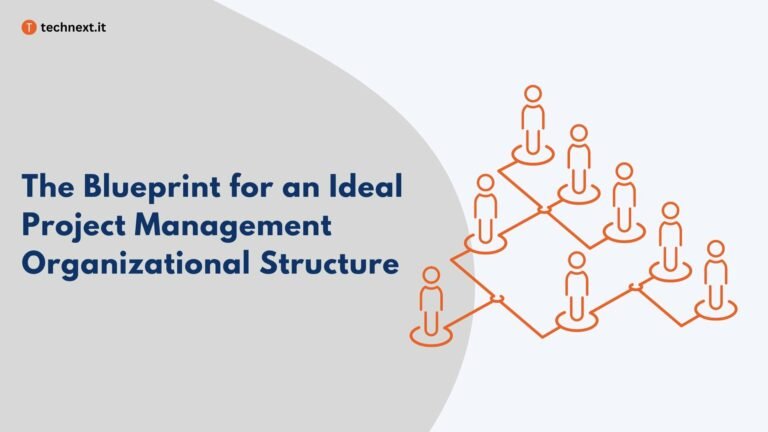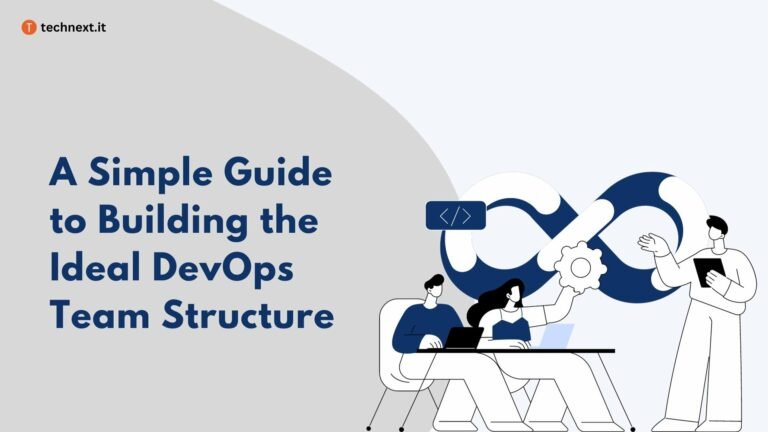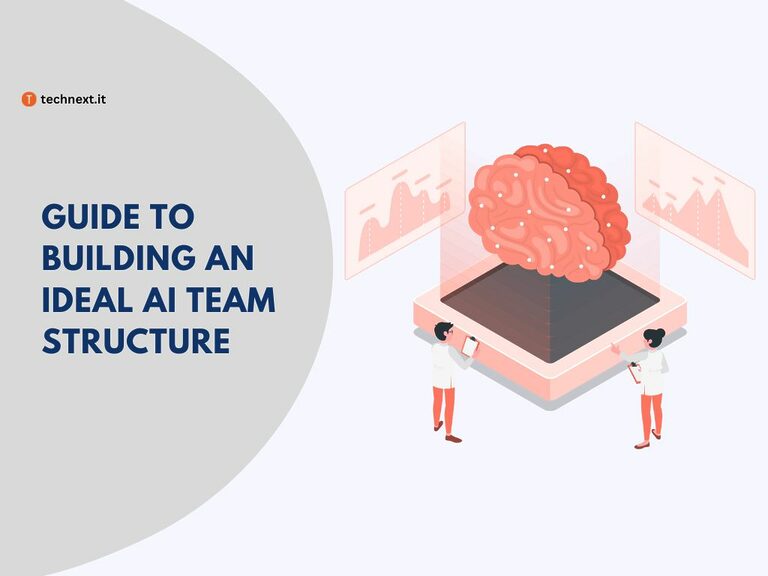Complete Guide to an Ideal Customer Success Team Structure
Figure out the perfect customer success team structure for your business by understanding the concept, roles, and general approaches others utilize.
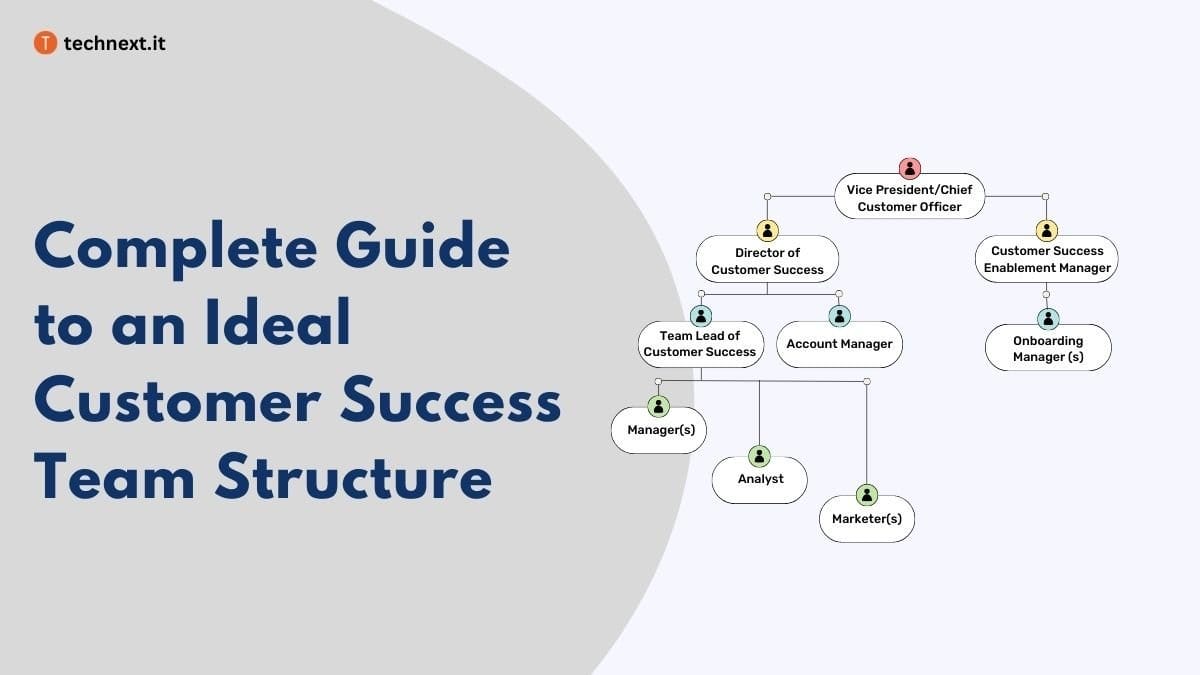
The growing businesses of the world are increasingly emphasizing customer success nowadays and setting up their customer success teams. In fact, a study shows 70% of those business leaders mark customer success as very important.
Although CEOs have understood it is one of the most cost-effective ways to run and grow a business today, they still have some common questions, especially regarding their customer success strategy.
As the customer success team structure forms the organizational backbone that supports the cs strategy, we are going to explore this topic first. Let’s get started.
What is Customer Success, and Why It Matters?
Customer success is a fascinating approach to helping your customers achieve their desired outcomes by utilizing your products or services most efficiently.
The goal of customer success is to improve your customer satisfaction, trust, and engagement, as well as drive revenue growth for the business.
Effective customer success is all about connecting with your customers, learning about their needs and goals, and then helping them achieve with the support, resources, and direction they need.
With all the focus on the customer and experiences overlapping, it’s easy to become confused between customer success and customer service. The two are distinct from one another. Most of the customer support interactions are tightly focused on specific customer problems. The customer contacts the company for assistance, and the customer support team resolves the issue.
On the other hand, customer success is more concerned with assisting clients in achieving broad business objectives. Your team forms a bond with your customers. They learn about your customer’s goals and assist the customer in achieving those goals by providing training and strategic counsel.
Now that you understand the basics, let me explain why customer success is essential for your startup.
- You can develop solid relationships with your consumers, which can result in increased customer loyalty and retention.
- Your customer brand experience and product satisfaction directly result in customer success. Successful customer journeys give customers a positive brand experience.
- If you are a saas or subscription-based business owner, you know renewal depends on customers seeing value and success with the product; customer success can help you.
- Customer success helps you to increase revenue growth by reducing churn and increasing customer lifetime value (LTV).
- By gaining valuable insights from customer success initiatives, you can prevent future customer problems and identify consumer demands.
Responsibilities of a Customer Success Team
So far, we’ve highlighted the immense value a customer success team brings to your business. Let’s break down what a customer success team does and their responsibilities.
Taking Over from the Sales Department
Your customer success teams take over from sales teams after sales conversations and processes. At this point, your customer success team needs to sync with your sales team and present the customer with all the information to manage the customer churn rate. If they execute this right, your customer will be delighted and understand your company’s positive bottom line.
User onboarding process
User onboarding is crucial for ensuring your customer success.
Some companies use email campaigns, calls, or webinars for one-to-many onboarding. But there is no need for a long onboarding process- your team can direct users on the quickest route to success via minimum-viable onboarding, as your goal is getting active users as soon as possible.
Improve the customer experience by educating them
Another responsibility of customer success teams is educating customers about your product and services, although it’s an ongoing process. You can also have a dedicated education or training team. Depending on your customer engagement model, your team can educate the customers through channels such as in-app guides, video tutorials, a knowledge base, one-to-one strategy sessions, etc.
Providing customer support
Your first-time customers face many problems, and your customer success teams help customers overcome these obstacles. Also, sometimes they need to support the clients they are managing. The customer success team usually focuses on product adoption and answers “how-to” questions instead of dealing with product issues.
Representing the customer by collecting feedback and suggestions
Your customer success team represents your customers by collecting feedback, identifying pain points, and measuring satisfaction levels. You can use various channels to collect active and passive feedback, such as NPS surveys, customer satisfaction surveys, in-app feature surveys, reviews, etc. Sometimes the customer’s requests and needs can differ from the company’s vision, and as the most customer-involved team, they need to balance these opposing viewpoints.
Help the customers with renewals
Your customer success team can assist your customers with renewal to keep the customer churn rate low. They can achieve this by demonstrating the product’s value and providing the necessary information to the customers. Also, the team can suggest features or upgrades that could benefit the customer based on their goals to retain customers.
Building relationships and monitoring customer health scores
Another responsibility of your customer success team is making ongoing connections with customers to gain customer loyalty. You can increase customer loyalty by offering loyalty programs, rewards, personalized offers, and guidance based on in-app activity and events. Also, you can monitor customer health, a custom score that you can measure by combining product usage, service usage, and login metrics, which shows your customer’s chance to renew and the product’s most and least used regions.
Conveying customer insights to other teams
One of the vital roles of your customer success team is to share customer insight with other teams so that they can improve. For example, your marketing can analyze the insights and create more relatable and helpful content for the customers. This will also help your marketing team to get better leads.
A collaboration between your customer success team and engineering team often ends up improving your product as your customer demand. When product and engineering teams plan for the future, the customer success team provides feedback on the usefulness of new updates based on customer needs.
Creating preselling and upselling opportunities
Your customer success team can participate in pre-sales with sales.
They can help the sales team with information and suggestions before and after sales, this involvement makes the handover and transition easy.
Sometimes the plan that the customer is using can dissatisfy them. The customer success team is responsible for convincing the customer
how your other product offerings can meet their demands to set up upselling opportunities for new solutions.
Connecting the customer with the necessary teams
Your success team may not answer all your customer’s questions, but they know the best person to answer those questions. These lead us to their role of connecting customers to the appropriate resources within the company for efficient and effective problem-solving.
Documenting Customer Success Stories
Customer success teams are the best ones to put together these social proofs because they know every step of a customer’s journey, both normal and special. They can document customer success stories and case studies to help promote your business and product by showing how well it has worked for others and convince some other customers to purchase your product.
The Common Roles in a Customer Success Team
Now it’s time to discuss the team. Each team member has a specific role that contributes to the team’s overall success. Customer success team roles can vary depending on your product or service or the customer base’s size or complexity. Here I have discussed some common roles in a customer success team.
Vice President of customer success
Vice President of Customer Success (VP of CS) is a senior leadership role of your CS team. He /She is responsible for bringing a strategic vision and innovative approach to ensure customer success. He/she is also responsible for leading and managing the customer success team.
Chief Customer Officer (CCO)
Chief Customer Officer (CCO) is also a high-level executive of your CS team. He/She is often responsible for the overall customer experience and success of a company. They are also responsible for calculating revenue growth and motivating the customer success team to meet customer-centric goals.
Director of Customer Success
The customer Success Director is a senior executive of your team whose role is to build and manage the relations with your customer base to ensure their continued growth, engagement, and retention.
Team Lead of Customer Success
The team Lead of your CS team is the person who leads and supervises a team of customer success managers. He/ she manages the team’s day-to-day activities and ensures customer success meets the overall goal. Their responsibilities also include planning training programs and developing and tracking metrics for both team and customer.
Customer Success Managers
Customer Success Manager (CSM) assists customers individually by guiding them throughout their customer journey and establishing a positive relationship. He/she is focused on customer loyalty and building close long-term client relationships.
Onboarding Manager
Also known as an onboarding specialist. He/she is responsible for helping new customers onboard with your product or service, guiding them through the setup process, and ensuring a smooth experience.
Customer Success Analyst
Your customer success analyst’s main responsibility is to find trends, growth chances, and potential areas for improvement by analyzing customer information and identifying patterns. They also provide insights and recommendations to help improve the overall customer experience.
Customer Success Enablement Manager
The person who is responsible for all customer success employees are fully trained and qualified with the essential skills and resources to perform their tasks efficiently is your customer success enablement manager.
Account Manager
Your account manager are responsible for specific customer accounts. They manage and grow the customer’s account, identify upsell opportunities, and renew contracts.
Customer Marketer
Customer success marketers help the team retain customers and ensure consistency throughout your customer lifecycle. They create large-scale material and customer communications to convince customers to renew, buy again, and recommend your products.
Digital Success Manager
He/she is the IT person for your customer success team. They are responsible for keeping your customer success software and other virtual things like tracking customer data up to date.
A Look at the Typical Customer Success Team Structure
The structure of your Customer Success team depends on the size, complexity, and go-to-market strategy of your organization. If you have a new customer team, you may have one or a few managers handling all responsibilities. But your fast-growing team may need more specialized roles, such as operations and onboarding, to increase productivity and efficiency.
It is not possible for me to form a magical customer success team structure that works for all organizations. Perhaps I can introduce you to the most common structure of a typical starter customer success team so that you get an idea and know how to structure a customer success team that works best for your organization.
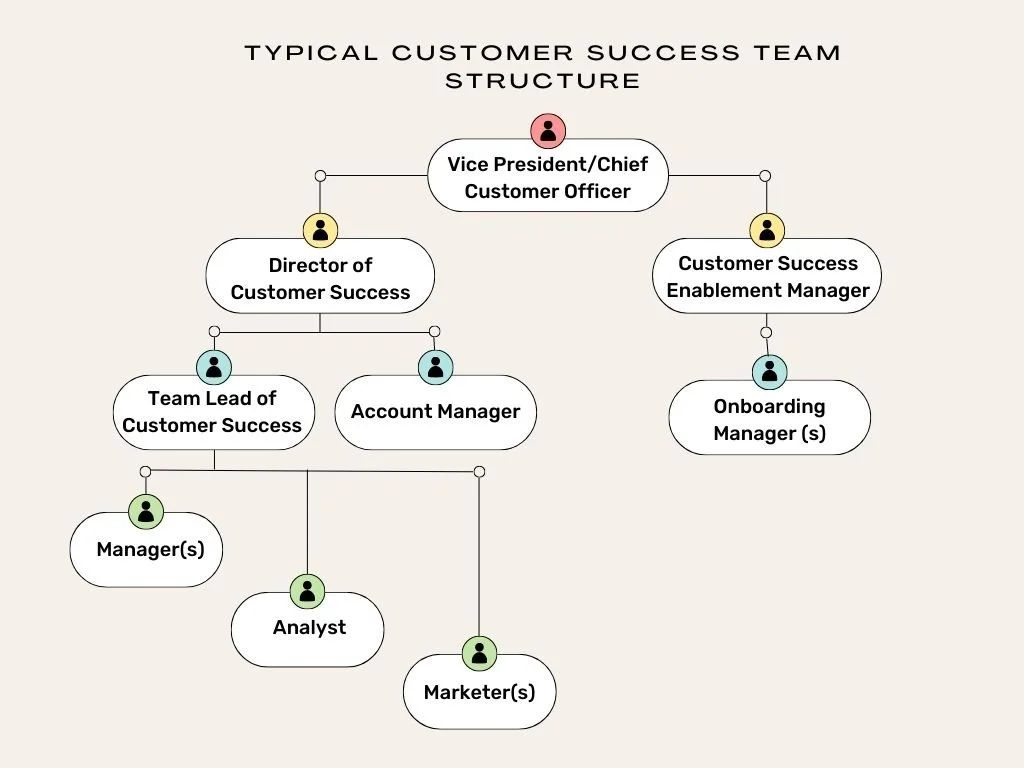
The customer success team of a small or mid-sized business usually have a vice president of customer success or chief customer officer (CCO) as a high-level executive of the CS team; some organizations keep both posts if needed.
The director of customer success and customer success enablement manager works directly under the CCO. Onboarding Managers works with customer success enablement manager.
The director manages the team lead of customer success and account managers. Customer success managers, analysts, and marketers report to your team lead.
The Right Time to Build Your Customer Success Team
So far, you understand the roles and structure of a customer success team. But you might be wondering when is the right time to build one? Should I wait until I have a certain number of customers, or should I prioritize them from the start?
Let me help you even though there is no definitive answer, and it differs from company to company. But still, I will try to break down some narrations here.
First, you don’t have to form a whole customer success team right after you lunch your startup, just like your customer support team. You can wait until you have a few customers and collect data about their wants and needs; this will add more value to the team. Then you can start by hiring an experienced leader and eventually expand to a fully functional team parallel to your customer base and need.
You can also keep your eye on some indicators like – your customer churn rate is high or your customer feedback and satisfaction levels are low. Then we recommend you form a customer success team. They can take the necessary steps to handle the problems causing churn and customer dissatisfaction.
Best Practices for Building a Customer Success Team
Forming your customer success team is just the start. If you want to build a perfect customer success team that satisfies your customer’s needs and provides great value to your company. You need to establish some practices.
Unraveling the meaning of success as understood by your customers
To make sure your customers’ goals for customer success are met, you need to understand your customers’ objectives for customer success clearly. This way, you can combine them into your product and be prepared for the customer success journey. You can use email surveys, phone calls, conferences, and industry contacts to start a conversation and gather information on each customer’s unique goals and definitions of success.
Cultivating Customer Loyalty
You can build personalized relationships with customers by going above and beyond to help them along their journey and keep them interested with a dedicated customer success team. When customers feel valued and cared for, their trust and loyalty grow, which helps your business keep more customers.
Dividing Your Customer Base
Clustering your customer base into meaningful groups can help optimize your customer success team efforts. Different groups are going to have different needs. By understanding these varying needs, your success team can focus on relevant features and interactions, tailoring their support accordingly, and can significantly enhance the effectiveness of your customer success program.
Build a Customer-Centric Brand Reputation
As the primary point of contact, your customer success team delivers a positive experience by providing excellent service, showing empathy, and maintaining transparency. They create a positive experience that prompts customers to share their satisfaction with others. Through word-of-mouth referrals, your brand reputation grows, and you got to establish a brand reputation centered around customer-centricity.
Crafting a Roadmap for Customer Success
Your team needs to outline the entire customer journey process on a map, including handoffs, tools, feedback loops, and decisions, as your customer success involves multiple teams and departments, leading to communication challenges and missteps. Having a comprehensive map or visual representation like a flowchart can make everyone’s job easier for your team and provide valuable insights and guidance.
I hope you liked our guide on customer success team structure. Remember, the ideal team structure can differ, so I suggest you consult an expert before defining the structure for your customer success team.
If you are setting up teams then you may also read, Tech Startup Team Structure and startup marketing team structure.
Best of Luck!

